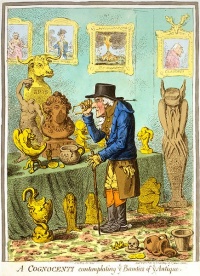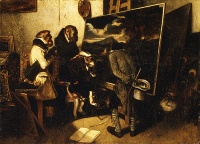Art dealer
From The Art and Popular Culture Encyclopedia


|
Related e |
|
Featured: |
An art dealer is a person or company that buys and sells works of art.
An art dealer typically seeks out various artists to represent, and builds relationships with collectors and museums whose interests are likely to match the work of the represented artists. Some dealers are better than others at anticipating market trends. Some prominent dealers may be able to influence the taste of the market. Many dealers specialize in a particular style, period, or region.
Some people find their way into becoming art dealers by studying the history of art. Related careers that often cross-over include curators from museums and art auction firms. Related careers include being an art critic or an art academic.
Can you tell a Picasso from a Kandinsky? How about a daVinci from a Botticelli? If you love art, but you’re better at business than painting, you might consider becoming an art dealer.
Art dealers travel, often internationally, to exhibitions, auctions, and artists’ studios, looking for good buys, little-known treasures, and exciting new works. Most dealers specialize in the art of a particular period or region. One might deal in contemporary Canadian art, another in seventeenth century Dutch painting, another in abstract art of the 1950s and 1960s.
You can also specialize in areas such as folk art. One recent trend that has attracted a lot of dealers and collectors is “outsider art”—the works of people who have little or no formal training in art and who don’t identify themselves as artists (or didn’t until people started buying their creations).
When dealers buy works of art, they resell them either in their galleries or directly to collectors. Those who deal in contemporary art usually exhibit artists’ works in their galleries, and take a percentage of the price the works sell for.
Dealers have to understand the business side of the art world. They keep up with trends in the market and are knowledgeable about the style of art people want to buy. They figure out how much they should pay for a piece and estimate what they can resell it for. But they are also passionate and knowledgeable about art. They recognize the styles of different periods and individual artists. Most of the time, they can tell authentic works from forgeries (although even dealers are sometimes fooled). Those who deal with contemporary art promote new artists, creating a market for their works and enabling them to make a living.
To determine an artwork’s value, dealers inspect the objects or paintings closely, and compare the fine details with similar pieces. Some dealers with many years of experience learn to identify unsigned works by examining stylistic features such as brush strokes, color, form.
Contents |
Notable art dealers
Head of the multimillion dollar Gagosian Gallery group.
Glimcher is the founder of The Pace Gallery and is widely known as one of the art world's most powerful dealers. The Pace Gallery represents contemporary artists including Chuck Close, Tara Donovan, David Hockney, Maya Lin and Kiki Smith. It also represents the estates of several artists, including Pablo Picasso, Agnes Martin, Ad Reinhardt, and Alexander Calder. During his career he has worked closely with important artists including Jean Dubuffet, Robert Rauschenberg, Louise Nevelson, and Lucas Samaras. In 2007, Glimcher received the Distinguished Alumni Award from the Massachusetts College of Art and Design.
Halpert was born in 1900 in Odessa, arrived in the U.S. as a penniless Russian Jewish immigrant and grew to become a pioneering New York City art dealer, transforming the landscape of Modern art. Over her forty year career from 1926 through the 1960's, Halpert brought recognition and market success to many avant-garde American artists. Her establishment The Downtown Gallery, one of the first in Greenwich Village, introduced and showcased many modern art luminaries. Halpert died at age 70 a multimillionaire, with Sotheby's crediting her with having put modernist painting auctions on the map. Its posthumous sale of her collection went for $3.6 million in 1973.
Perls (1912–2008) was born and raised in Berlin. He studied art history in Munich, but was forced to finish his education in Basel, Switzerland, as the Nazis were no longer allowing degrees for Jews. He ran Perls Galleries for over 60 years. His gallery dealt with contemporary American artists, modern works from the School of Paris and Mexican and South American art. Perls also developed an interest in art from Benin and built a sizable collection. He was not only an art dealer, but also a donor as he contributed many significant works of art to the Metropolitan Museum of Art. He died June 2, 2008 in Mount Kisco, N.Y. at age 96.
Struever was born in 1931 in Milan, Indiana. She attended the Tobé-Coburn School For Fashion Careers in New York City, after obtaining her bachelor's of science degree from Purdue University in Lafayette, Indiana in 1953. She began collecting and dealing in American Indian art in 1971, and is regarded as a leading scholar on historic and contemporary Pueblo Indian pottery and Pueblo and Navajo Indian jewelry. She has authored books on Charles Loloma, the foremost American Indian jeweler, and Dextra Quotskuyva, the pre-eminent contemporary Hopi potter, as well as exhibition catalogues on Hopi potter Iris Nampeyo and other Hopi art, and has guest curated museum shows in several cities.
German-born Seligmann (1858–1923) moved to Paris in 1874 where he set up an antiquarian business in 1880. Benefiting from the interest of clients such as Edmond de Rothschild, he moved to the Place Vendôme in 1900 and in 1904 opened an office in New York. In 1909, he acquired the Hôtel de Monaco in Paris where he was able to impress his more important clients such as the Russian Stroganoff family and the high-flying British politician Sir Philip Sassoon. In New York, he developed interest in European art attracting collectors such as Benjamin Altman, William Randolph Hearst and J. P. Morgan. On his death, his son Germain Seligman continued to run Jacques Seligmann & Company.
Weber was born in 1932 in Los Angeles. He was a radio corpsman in the Navy during the Korean War before receiving a bachelor’s degree from Antioch College in Yellow Springs, Ohio in 1958. As a contemporary art dealer, Weber was ahead of his time as he was one of the early promotors of Conceptual Art, Post-Minimalist sculpture and Italian Arte Povera. He was the director of several galleries throughout his career and helped organize shows that featured big names such as Robert Indiana, Richard Long and Andy Warhol. Weber died May 23, 2008 in Hudson, N.Y. at age 75.
More notable art dealers
- Paul Durand-Ruel 1831 – 1922
- Duveen Brothers, (Joseph Joel Duveen 1843-1908, and Henry J. Duveen 1855-1918)
- Georges Petit 1856 – 1920
- Berthe Weill 1865 – 1951
- Ambroise Vollard 1866 – 1939
- Joseph Duveen, 1st Baron Duveen 1869 – 1939
- Paul Cassirer 1871 – 1926
- Léonce Rosenberg 1879 - 1947
- René Gimpel 1881 — 1945
- Paul Rosenberg 1881 - 1959
- Daniel-Henry Kahnweiler 1884 – 1979
- Pierre Matisse 1900 – 1989
- Sidney Janis 1896 – 1989
- Betty Parsons 1900 – 1982
- Leo Castelli 1907 – 1999
- Ileana Sonnabend 1914 – 2007
- Daniel Wildenstein 1917 – 2001
- André Emmerich 1924 – 2007
More art dealers
See also
- Appraiser
- Art finance
- Art market
- Art sale
- Art valuation
- Art world economics
- Auction
- Blockage discount
- Curator

